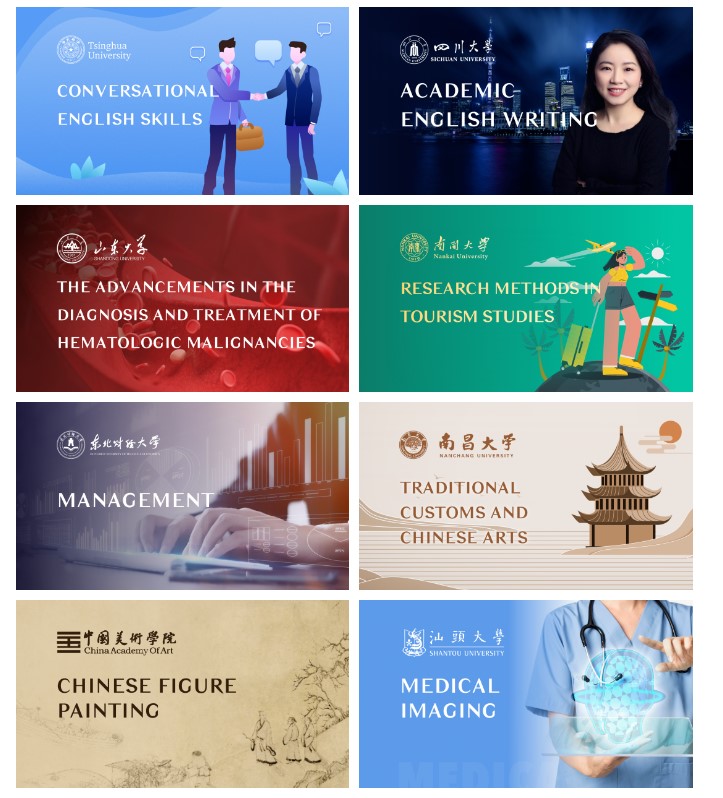With the help of digital screens, cameras and internet cables, university students from around the world are now joining online classrooms of Chinese universities.
"It's hard to find such courses in Indonesia. I truly appreciate this chance," said a student from Universitas Terbuka in Indonesia, who studied urban environmental engineering with students from China's Tsinghua University on an online platform. Without the need to travel abroad, he was able to access the exceptional educational resources of China's prestigious universities.
These high-quality resources of higher education are called massive open online courses (MOOCs) in China, which are particularly attractive due to their ability to disseminate knowledge far and wide, breaking geographical barriers for those eager to learn.

Photo shows some of the high-level online courses on XuetangX, a renowned MOOCs platform in China. (Photo from an official account of XuetangX on WeChat)
By the end of 2024, China's smart platform for higher education had launched 31,000 online courses and recorded over 93 million views from users in 183 countries and regions. Platforms like iCourse and XuetangX have offered more than 1,000 courses in 14 languages to global learners, with 670,000 course views recorded.
From a humble beginning with only five courses and a few hundred users, Chinese MOOCs have become globally recognized educational resources, representing China's efforts to deepen the opening-up of education.
Knowledge is a ladder of human progress. However, in some countries, knowledge remains a scarce resource due to underdeveloped higher education. It is an urgent and long-term task to resolve imbalances and inadequacies in global development and bridge the knowledge gap.
The Chinese MOOCs, characterized by the deep integration of digital technologies and higher education, have delivered open access to knowledge, helping to close the knowledge gap and promote inclusive knowledge sharing.
Many Chinese universities are offering high-quality MOOCs to learners around the world. For instance, Xi'an Jiaotong University has launched a training program that provides nearly 100 international courses under dozens of subjects, benefiting over 10,000 students and business persons from more than 100 countries and regions. Under the framework of the Belt and Road Initiative, Southwest Jiaotong University has cultivated over 5,000 rail transit professionals from more than 80 countries through online courses.
The ever-expanding global presence of Chinese MOOCs has made high-quality educational resources available in more countries, enhancing the accessibility of higher education in the Global South.
Enhancing services for global digital education
As Chinese MOOCs move from version 1.0 to 2.0, China is shifting from the global provision of educational resources and activities to a greater focus on enhancing services and standards.
China has strengthened collaboration with foreign universities to share courses and implement mechanisms for mutual recognition of credits. The country is also exploring more appealing methods for transforming learning outcomes, such as micro-credential programs.
It has spearheaded the establishment of the Global MOOC and Online Education Alliance, collaborating with over 30 renowned universities and online education institutions worldwide to foster two-way communication channels for the exchange of courses.
The country has also issued the Beijing Declaration on MOOC Development and reports on the digital development of global higher education to proactively share its digital education experience with the rest of the world.
The global popularity of Chinese MOOCs represents China's proactive efforts to expand the opening up in education and promote the digital transformation of global higher education.
Joining hands on path toward educational modernization
From a modern perspective, education is the cornerstone of development for any country. As an old Chinese saying goes: "It is more important to show people how to fish than just giving them fish." While seeking its own educational development, China hopes to join hands with other countries on the path toward modernization.
From the global development of Chinese MOOCs to the uniquely designed Luban Workshops and Silk Road Schools contributing to local development, what China brings to the world are not only tangible projects but also momentum for development. The international development of Chinese MOOCs exactly illustrates China's wisdom of offering both "fish" and the "skills to fish."
China cannot be separated from the world in achieving development, and the world also needs China for prosperity. In the "harmonious symphony" of mutual progress between China and the world, education plays beautiful notes. By bringing more teachers and students together online, spreading knowledge across mountains and seas, and continuously expanding the map of international educational cooperation, China is making steady progress and will never cease its steps.


